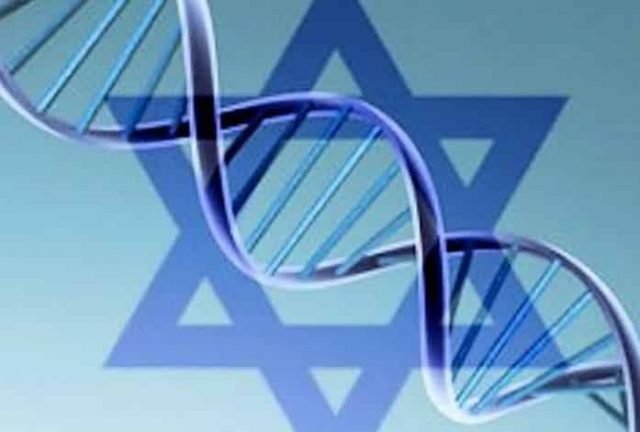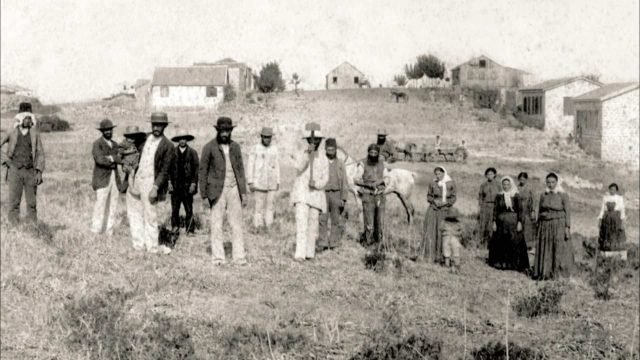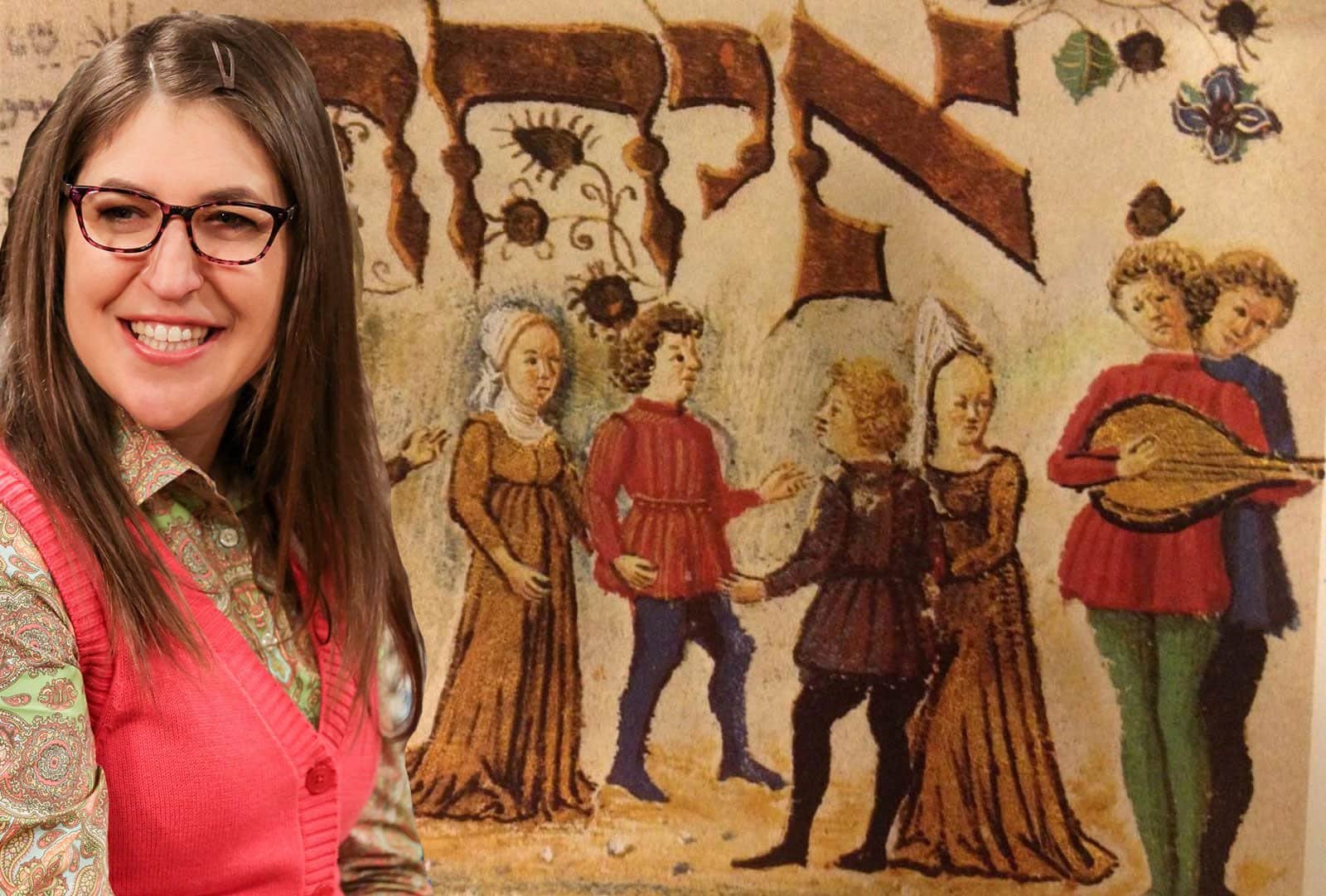by Johnny Punish
Today, I watched a super interesting fantastic fun video by Big Bang Theory Hollywood star Mayim Bialik where she takes the DNA test and discovers her origins (Mayim Bialik: My DNA Results REVEALED! Sponsored by 23andMe)
In the video, she reveals she’s 99.7% Ashkenazi Jewish among some Irish, English, and broadly Europan ancestry.
 She correctly acknowledges that we can track our origins through mitochondrial DNA, which, in her case, reveals she’s actually, on the female side, from Southern Europe between 10,000 and 20,000 B.C. which questions the claim that 23andMe says she is 99.7% Jewish because the first reference to Judaism comes from 1830.B.C…but more on that later.
She correctly acknowledges that we can track our origins through mitochondrial DNA, which, in her case, reveals she’s actually, on the female side, from Southern Europe between 10,000 and 20,000 B.C. which questions the claim that 23andMe says she is 99.7% Jewish because the first reference to Judaism comes from 1830.B.C…but more on that later.
What really got me as I was watching the video was the following questions;
- Isn’t Judaism a religion?
- Why is 23andMe along with Ancestry.com telling people they are of the Jewish religion as an origin but NOT using Christianity or Islam as a standard as well?
- Why is being Jewish given a special standard even when there is NO evidence that DNA has coded instructions for religion?
- Why is this well-educated sharp lady being told her DNA is 99.7% Jewish when Judaism is a religion with the same twists and turns as so many religions and philosophies before and after its creation?
Lots of questions!
But what is NOT questioned is that religion is NOT in the genes! No religion or philosophy is in our genes! That is just plain science fact! Being an educated Ph.D. scholar herself from UCLA with degrees in neuroscience, Jewish studies and Hebrew, I assume Dr. Mayim knows this scientific fact. However, it does NOT take away the fun of her video or her enthusiasm to share with her fans. It’s just that this is getting ridiculous. We need to get this right!
Now, with great respect, Dr. Mayim Bialik is super proud of being Jewish. And this author extends his full respect to her and all those that engage in the very human endeavor of faith whether organized or not. But again, being Jewish is simply NOT a race or ethnicity. No religion is…that’s like saying to me that I am 99.7% Pagan or telling Trump he is 99.7% Christian or Kevin Barrett he’s 99.7% Muslim! This is just silly!
Oh wait, on the Trump Christian thing, I meant 99.7% Machevellian Predator with a few DNA pieces going to the tribe of Sociopath. LOL! So yeah, scratch the “Christian” thing… In fact, that’s an analysis is for another day. But you get my point!
Now, granted, Trump, the self-proclaimed smartest man in the world, signed a political order saying Jews are a race. (WAPO: Trump signs an order and provokes an identity crisis.)
But again, who cares what Doctor Drink and Inject Disinfectant to Cure COVID-19 says about anything. He’s a plain old political opportunist with a long portfolio of real evidence to make him King of the Fools who believe everything the pure profiteering opportunist says. So, for science’s sake, Silly Trump’s asinine opinion does NOT even make the “under consideration” file!
Nevertheless, let’s get serious about this…
Oh and please readers, no racism and bigotry okay! We don’t have patience or time for such silly disrespectful nonsense. Now, let’s go…
 Mayim Bialik, Ashkenazi Jew?
Mayim Bialik, Ashkenazi Jew?
Let’s examine…
Ashkenazi Jews, also known as Ashkenazic Jews or, by using the Hebrew plural suffix -im, Ashkenazim are a Jewish diaspora population who coalesced in the Holy Roman Empire around the end of the first millennium.
The traditional diaspora language of Ashkenazi Jews is Yiddish (a Germanic language with elements of Hebrew, Aramaic, and Slavic languages), developed after they had moved into northern Europe: beginning with Germany and France in the Middle Ages.
For centuries they used Hebrew only as a sacred language, until the revival of Hebrew as a common language in Israel. Throughout their time in Europe, Ashkenazim have made many important contributions to its philosophy, scholarship, literature, art, music, and science.
The term “Ashkenazi” refers to Jewish settlers who established communities along the Rhine River in Western Germany and in Northern France dating to the Middle Ages. Once there, they adapted traditions carried from Babylon, the Holy Land, and the Western Mediterranean to their new environment. The Ashkenazi religious rite developed in cities such as Mainz, Worms, and Troyes. The eminent French Rishon Rabbi Shlomo Itzhaki (Rashi) would have a significant influence on the Jewish religion.
In the late Middle Ages, due to religious persecution, the majority of the Ashkenazi population shifted steadily eastward, moving out of the Holy Roman Empire into the areas later part of the Polish–Lithuanian Commonwealth, comprising parts of present-day Belarus, Estonia, Latvia, Lithuania, Moldova, Poland, Russia, Slovakia and Ukraine.
In the course of the late 18th and 19th centuries, those Jews who remained in or returned to the German lands generated a cultural reorientation; under the influence of the Haskalah and the struggle for emancipation, as well as the intellectual and cultural ferment in urban centers, they gradually abandoned the use of Yiddish and adopted German, while developing new forms of Jewish religious life and cultural identity.
The Holocaust of the Second World War decimated the Ashkenazim, affecting almost every Jewish family. It is estimated that in the 11th century Ashkenazi Jews composed three percent of the world’s total Jewish population, while an estimate made in 1930 (near the population’s peak) had them as 92 percent of the world’s Jews.
Immediately prior to the Holocaust, the number of Jews in the world stood at approximately 16.7 million. Statistical figures vary for the contemporary demography of Ashkenazi Jews, ranging from 10 million to 11.2 million. Sergio Della Pergola, in a rough calculation of Sephardic and Mizrahi Jews, implies that Ashkenazi Jews make up 65–70% of Jews worldwide. Other estimates place Ashkenazi Jews as making up about 75% of Jews worldwide.
 Science Tells Us It’s In the Genes
Science Tells Us It’s In the Genes
Genetic studies on Ashkenazim—researching both their paternal and maternal lineages, as well as autosomal DNA—point to a predominantly Levantine ancestry with varying degrees of Southern European admixture.
These studies have arrived at diverging conclusions regarding both the degree and the sources of their European admixture, with some focusing on the extent of the Southern European genetic origin observed in Ashkenazi maternal lineages, which is in contrast to the predominantly Middle Eastern genetic origin observed in Ashkenazi paternal lineages.
Efforts to identify the origins of Ashkenazi Jews through DNA analysis began in the 1990s.
Currently, there are three types of genetic origin testing;
-
- autosomal DNA (atDNA)
- mitochondrial DNA (mtDNA)
- Y-chromosomal DNA (Y-DNA)
Autosomal DNA is a mixture from an individual’s entire ancestry, Y-DNA shows a male’s lineage only along his strict paternal line, mtDNA shows any person’s lineage only along the strict maternal line. Genome-wide association studies have also been employed to yield findings relevant to genetic origins.
DNA Studies
Like most DNA studies of human migration patterns, the earliest studies on Ashkenazi Jews focused on the Y-DNA and mtDNA segments of the human genome. Both segments are unaffected by recombination (except for the ends of the Y chromosome – the pseudoautosomal regions are known as PAR1 and PAR2), thus allowing tracing of direct maternal and paternal lineages.
These studies revealed that Ashkenazi Jews originate from an ancient (2000 BCE – 700 BCE) population of the Middle East who had spread to Europe. Ashkenazic Jews display the homogeneity of a genetic bottleneck, meaning they descend from a larger population whose numbers were greatly reduced but recovered through a few founding individuals.
Although the Jewish people, in general, were present across a wide geographical area as described, genetic research done by Gil Atzmon of the Longevity Genes Project at Albert Einstein College of Medicine suggests
“that Ashkenazim branched off from other Jews around the time of the destruction of the First Temple, 2,500 years ago … flourished during the Roman Empire but then went through a ‘severe bottleneck’ as they dispersed, reducing a population of several million to just 400 families who left Northern Italy around the year 1000 for Central and eventually Eastern Europe.”
Various studies have arrived at diverging conclusions regarding both the degree and the sources of the non-Levantine admixture in Ashkenazim, particularly with respect to the extent of the non-Levantine genetic origin observed in Ashkenazi maternal lineages, which is in contrast to the predominant Levantine genetic origin observed in Ashkenazi paternal lineages.
All studies nevertheless agree that genetic overlap with the Fertile Crescent exists in both lineages, albeit at differing rates. Collectively, Ashkenazi Jews are less genetically diverse than other Jewish ethnic divisions, due to their genetic bottleneck.
Male lineages: Y-chromosomal DNA
The majority of genetic findings to date concerning Ashkenazi Jews conclude that the male lines were founded by ancestors from the Middle East.
A study of haplotypes of the Y-chromosome, published in 2000, addressed the paternal origins of Ashkenazi Jews. Hammer et al. found that the Y-chromosome of Ashkenazi and Sephardic Jews contained mutations that are also common among other Middle Eastern peoples, but uncommon in the autochthonous European population.
This suggested that the male ancestors of the Ashkenazi Jews could be traced mostly to the Middle East. The proportion of male genetic admixture in Ashkenazi Jews amounts to less than 0.5% per generation over an estimated 80 generations, with “relatively minor contribution of European Y chromosomes to the Ashkenazim,” and a total admixture estimate “very similar to Motulsky’s average estimate of 12.5%.”
This supported the finding that “Diaspora Jews from Europe, Northwest Africa, and the Near East resemble each other more closely than they resemble their non-Jewish neighbors.” “Past research found that 50–80 percent of DNA from the Ashkenazi Y chromosome, which is used to trace the male lineage, originated in the Near East,” Richards said. The population has subsequently spread out.
A 2001 study by Nebel et al. showed that both Ashkenazi and Sephardic Jewish populations share the same overall paternal Near Eastern ancestries.
In comparison with data available from other relevant populations in the region, Jews were found to be more closely related to groups in the north of the Fertile Crescent. The authors also report on Eu 19 (R1a) chromosomes, which are very frequent in Central and Eastern Europeans (54–60%) at an elevated frequency (13%) in Ashkenazi Jews.
They hypothesized that the differences among Ashkenazim Jews could reflect low-level gene flow from surrounding European populations or genetic drift during isolation. A later 2005 study by Nebel et al., found a similar level of 11.5% of male Ashkenazim belonging to R1a1a (M17+), the dominant Y-chromosome haplogroup in Central and Eastern Europeans.
However, a 2017 study, concentrating on the Ashkenazi Levites where the proportion reaches 50% while signaling that there’s a “rich variation of haplogroup R1a outside of Europe which is phylogenetically separate from the typically European R1a branches”, precises that the particular R1a-Y2619 sub-clade testifies for a local origin, and that the “Middle Eastern origin of the Ashkenazi Levite lineage based on what was previously a relatively limited number of reported samples, can now be considered firmly validated.”

Female lineages: Mitochondrial DNA
Before 2006, geneticists had largely attributed the ethnogenesis of most of the world’s Jewish populations, including Ashkenazi Jews, to Israelite Jewish male migrants from the Middle East and “the women from each local population whom they took as wives and converted to Judaism.”
Thus, in 2002, in line with this model of origin, David Goldstein, now of Duke University, reported that unlike male Ashkenazi lineages, the female lineages in Ashkenazi Jewish communities “did not seem to be Middle Eastern”, and that each community had its own genetic pattern and even that “in some cases, the mitochondrial DNA was closely related to that of the host community.”
In his view, this suggested;
“that Jewish men had arrived from the Middle East, taken wives from the host population and converted them to Judaism, after which there was no further intermarriage with non-Jews.”
In 2006, a study by Behar et al., based on what was at that time high-resolution analysis of haplogroup K (mtDNA), suggested that about 40% of the current Ashkenazi population is descended matrilineally from just four women, or “founder lineages”, that were “likely from a Hebrew/Levantine mtDNA pool” originating in the Middle East in the 1st and 2nd centuries CE. Additionally, Behar et al. suggested that the rest of Ashkenazi mtDNA is originated from ~150 women and that most of those were also likely of Middle Eastern origin.
In reference specifically to Haplogroup K, they suggested that although it is common throughout western Eurasia, “the observed global pattern of distribution renders very unlikely the possibility that the four aforementioned founder lineages entered the Ashkenazi mtDNA pool via gene flow from a European host population”.
In 2013, a study of Ashkenazi mitochondrial DNA by a team led by Martin B. Richards of the University of Huddersfield in England reached different conclusions, in line with the pre-2006 origin hypothesis.
Testing was performed on the full 16,600 DNA units composing mitochondrial DNA (the 2006 Behar study had only tested 1,000 units) in all their subjects, and the study found that the four main female Ashkenazi founders had descent lines that were established in Europe 10,000 to 20,000 years in the past while most of the remaining minor founders also have a deep European ancestry.
The study argued that the great majority of Ashkenazi maternal lineages were not brought from the Near East or the Caucasus, but instead assimilated within Europe, primarily of Italian and Old French origins.
The Richards study estimated that more than 80 percent of Ashkenazi maternal ancestry comes from women indigenous to Europe, and only 8 percent from the Near East, while the origin of the remainder is undetermined.
According to the study these findings “point to a significant role for the conversion of women in the formation of Ashkenazi communities.” Karl Skorecki criticized the study for perceived flaws in phylogenetic analysis. “While Costa et al have re-opened the question of the maternal origins of Ashkenazi Jewry, the phylogenetic analysis in the manuscript does not ‘settle’ the question.”
A 2014 study by Fernández et al. found that Ashkenazi Jews display a frequency of haplogroup K in their maternal DNA, suggesting an ancient Near Eastern matrilineal origin, similar to the results of the Behar study in 2006. Fernández noted that this observation clearly contradicts the results of the 2013 study led by Richards that suggested a European source for 3 exclusively Ashkenazi K lineages.

Association and linkage studies
In genetic epidemiology, a genome-wide association study (GWA study, or GWAS) is an examination of all or most of the genes (the genome) of different individuals of a particular species to see how much the genes vary from individual to individual. These techniques were originally designed for epidemiological uses, to identify genetic associations with observable traits.
A 2006 study by Seldin et al. used over five thousand autosomal SNPs to demonstrate the European genetic substructure. The results showed “a consistent and reproducible distinction between ‘northern’ and ‘southern’ European population groups”. Most northern, central, and eastern Europeans (Finns, Swedes, English, Irish, Germans, and Ukrainians) showed >90% in the “northern” population group, while most individual participants with southern European ancestry (Italians, Greeks, Portuguese, Spaniards) showed >85% in the “southern” group. Both Ashkenazi Jews, as well as Sephardic Jews, showed >85% membership in the “southern” group. Referring to the Jews’ clustering with southern Europeans, the authors state the results were “consistent with a later Mediterranean origin of these ethnic groups”.
A 2007 study by Bauchet et al. found that Ashkenazi Jews were most closely clustered with Arabic North African populations when compared to the global population, and in the European structure analysis, they share similarities only with Greeks and Southern Italians, reflecting their east Mediterranean origins.
A 2010 study on Jewish ancestry by Atzmon-Ostrer et al. stated “Two major groups were identified by principal component, phylogenetic, and identity by descent (IBD) analysis: Middle Eastern Jews and European/Syrian Jews. The IBD segment sharing and the proximity of European Jews to each other and to southern European populations suggested similar origins for European Jewry and refuted large-scale genetic contributions of Central and Eastern European and Slavic populations to the formation of Ashkenazi Jewry”, as both groups – the Middle Eastern Jews and European/Syrian Jews – shared common ancestors in the Middle East about 2500 years ago.
The study examines genetic markers spread across the entire genome and shows that the Jewish groups (Ashkenazi and non-Ashkenazi) share large swaths of DNA, indicating close relationships and that each of the Jewish groups in the study (Iranian, Iraqi, Syrian, Italian, Turkish, Greek and Ashkenazi) has its own genetic signature but is more closely related to the other Jewish groups than to their fellow non-Jewish countrymen.
Atzmon’s team found that the SNP markers in genetic segments of 3 million DNA letters or longer were 10 times more likely to be identical among Jews than non-Jews. Results of the analysis also tally with biblical accounts of the fate of the Jews.
The study also found that with respect to non-Jewish European groups, the population most closely related to Ashkenazi Jews are modern-day Italians. The study speculated that the genetic-similarity between Ashkenazi Jews and Italians may be due to inter-marriage and conversions in the time of the Roman Empire. It was also found that any two Ashkenazi Jewish participants in the study shared about as much DNA as fourth or fifth cousins.
A 2010 study by Bray et al., using SNP microarray techniques and linkage analysis found that when assuming Druze and Palestinian Arab populations to represent the reference to world Jewry ancestor genome, between 35 and 55 percent of the modern Ashkenazi genome can possibly be of European origin, and that European “admixture is considerably higher than previous estimates by studies that used the Y chromosome” with this reference point.
Assuming this reference point the linkage disequilibrium in the Ashkenazi Jewish population was interpreted as “matches signs of interbreeding or ‘admixture’ between Middle Eastern and European populations”.
On the Bray et al. tree, Ashkenazi Jews were found to be a genetically more divergent population than Russians, Orcadians, French, Basques, Sardinians, Italians and Tuscans. The study also observed that Ashkenazim are more diverse than their Middle Eastern relatives, which was counterintuitive because Ashkenazim are supposed to be a subset, not a superset, of their assumed geographical source population. Bray et al. therefore postulate that these results reflect not the population antiquity but a history of mixing between genetically distinct populations in Europe.
However, it is possible that the relaxation of marriage prescription in the ancestors of Ashkenazim drove their heterozygosity up, while the maintenance of the FBD rule in native Middle Easterners has been keeping their heterozygosity values in check. Ashkenazim distinctiveness as found in the Bray et al. study, therefore, may come from their ethnic endogamy (ethnic inbreeding), which allowed them to “mine” their ancestral gene pool in the context of relative reproductive isolation from European neighbors, and not from clan endogamy (clan inbreeding). Consequently, their higher diversity compared to Middle Easterners stems from the latter’s marriage practices, not necessarily from the former’s admixture with Europeans.
The genome-wide genetic study carried out in 2010 by Behar et al. examined the genetic relationships among all major Jewish groups, including Ashkenazim, as well as the genetic relationship between these Jewish groups and non-Jewish ethnic populations.
The study found that contemporary Jews (excluding Indian and Ethiopian Jews) have a close genetic relationship with people from the Levant. The authors explained that “the most parsimonious explanation for these observations is a common genetic origin, which is consistent with a historical formulation of the Jewish people as descending from ancient Hebrew and Israelite residents of the Levant”.
A study by Behar et al. (2013) found evidence in Ashkenazim of mixed European and Levantine origins. The authors found the greatest affinity and shared ancestry of Ashkenazi Jews to be first with other Jewish groups from southern Europe, Syria, and North Africa, and secondly with both southern Europeans (such as Italians) and modern Levantines (such as the Druze, Cypriots, Lebanese and Samaritans).
In addition to finding no affinity in Ashkenazim with northern Caucasus populations, the authors found no more affinity in Ashkenazi Jews to modern south Caucasus and eastern Anatolian populations (such as Armenians, Azeris, Georgians, and Turks) than found in non-Ashkenazi Jews or non-Jewish Middle Easterners (such as the Kurds, Iranians, Druze and Lebanese).
A 2017 autosomal study by Xue, Shai Carmi et al. found an approximately even mixture of Middle-Eastern and European ancestry in Ashkenazi Jews: with the European component being largely Southern European with a minority being Eastern European, and the Middle Eastern ancestry showing the strongest affinity to Levantine populations such as the Druze and Lebanese.
The Khazar Connection
Main article: Preston James PhD – The Hidden History of the Incredibly Evil Khazarian Mafia
In the late 19th century, it was proposed that the core of today’s Ashkenazi Jewry are genetically descended from a hypothetical Khazarian Jewish diaspora who had migrated westward from modern Russia and Ukraine into modern France and Germany (as opposed to the currently held theory that Jews migrated from France and Germany into Eastern Europe).
The hypothesis is not corroborated by historical sources and is unsubstantiated by genetics, but it is still occasionally supported by scholars who have had some success in keeping the theory in the academic consciousness.[178]
The theory has sometimes been used by Jewish authors such as Arthur Koestler as part of an argument against traditional forms of antisemitism (for example the claim that “the Jews killed Christ”), just as similar arguments have been advanced on behalf of the Crimean Karaites. Today, however, the theory is more often associated with antisemitism[179] and anti-Zionism.
A 2013 trans-genome study carried out by 30 geneticists, from 13 universities and academies, from 9 countries, assembling the largest data set available to date, for assessment of Ashkenazi Jewish genetic origins found no evidence of Khazar origin among Ashkenazi Jews.
“Thus, analysis of Ashkenazi Jews together with a large sample from the region of the Khazar Khaganate corroborates the earlier results that Ashkenazi Jews derive their ancestry primarily from populations of the Middle East and Europe, that they possess considerable shared ancestry with other Jewish populations, and that there is no indication of a significant genetic contribution either from within or from north of the Caucasus region”, the authors concluded. The authors found no affinity in Ashkenazim with North Caucasus populations, as well as no greater affinity in Ashkenazim to the south Caucasus or Anatolian populations than that found in non-Ashkenazi Jews and non-Jewish Middle Easterners (such as the Kurds, Iranians, Druze, and Lebanese).
The greatest affinity and shared ancestry of Ashkenazi Jews were found to be (after those with other Jewish groups from southern Europe, Syria, and North Africa) with both southern Europeans and Levantines such as Druze, Cypriot, Lebanese and Samaritan groups.
CONCLUSIONS
Clearly, the DNA tells us that Ashkenazi Jews descend on the female side from Southern Europe about 10,000 to 20,000 B.C. and this causes a dilemma for DNA companies who are telling good people like Mayim Bialik that their origins are religious.
Jewish history begins with the covenant established between God and Abraham around 1812 BC (over 3,800 years ago), during the Bronze Age, in the Middle East. The Torah (Jewish Law), the primary document of Judaism, was said to be given to the Jews by the Prophet Moses (Moshe) about 3,300 years ago.
And that’s that! Mayim’s female ancestor who lived in Southern Europe around 20,000 B.C. was NOT Jewish. Based on what we know, the best we can say is that her ancestor was a modern human, whose ancestors probably bred with Neanderthals around 45,000-50,000 B.C. giving her trace evidence of Neanderthal DNA. Her ancestor was probably Pagan. We have NO evidence of religion from peoples during the time. We just don’t really know what they believed.
But that does NOT matter…..because religion is NOT a race or ethnicity. It cannot be found in our genes. We simply cannot deduce one’s religion scientifically.
Most likely, we can say that Mayim’s ancestors were Pagan, Jews, Christians, and Muslims. For a zillion reasons, people changed their religions over the centuries.
So technically speaking, Mayim’s DNA, comes from both the Middle East and Souther Europe well before Judaism appeared on the scene.
So this weird analysis by 23andMe.com and others like Ancestry.com who tell users they are descended from Ashkenazi Jew is, at best silly. At worst, it could be some broader plan to normalize this specific religion as a race to further some political agenda.
While there is lots of speculation on this from many around the world, there is NO direct evidence that these DNA companies are under “orders” from a higher source to sell this scientifically silly idea.
But what is NOT under dispute is that religions are NOT ethnicities no matter how many try to say are! Religion and faith have ZERO to do with genes.
We can actually take a baby from a Jewish family and place him halfway around the world into a Muslim country with a Muslim family and he will NOT magically turn Jewish due to his genes. Instead, he’s probably got a 99.7% chance of being raised Muslim. That’s just the way it is…
In other words, we cannot have a predisposition to be a Jew, Christian or Muslim no matter how hard the sellers of these religions wish it to be… why? Because, as famed Astrophysicist Neil De Grasse Tyson says
“The good thing about science is that it’s true whether or not you believe in it.”.
MEMO to Mayim
Hey girl, full respect for being proud of your Jewish heritage. That’s cool. But your DNA has NO Jewish instructions. No DNA has religious instructions!
In fact, DNA is made of chemical building blocks called nucleotides. These building blocks are made of three parts: a phosphate group, a sugar group and one of four types of nitrogen bases. To form a strand of DNA, nucleotides are linked into chains, with the phosphate and sugar groups alternating.
The four types of nitrogen bases found in nucleotides are adenine (A), thymine (T), guanine (G) and cytosine (C). The order, or sequence, of these bases, determines what biological instructions are contained in a strand of DNA. For example, the sequence ATCGTT might instruct for blue eyes, while ATCGCT might instruct for brown.
The complete DNA instruction book, or genome, for a human, contains about 3 billion bases and about 20,000 genes on 23 pairs of chromosomes; none of which are Jewish!

We’re All Human Beings
So this author says to everyone be proud of your origins. It’s fun to figure out where we come from. It gives us a center, a purpose. Let’s just be honest about it because we really need to raise up our awareness so we, as modern 21st-century human beings living together in a new globally connected world, can live well, at peace, and in harmony as one.
In fact, here’s some truth we can all connect to….
ALL OF US are HomoSapiens (Modern Humans) and all of us come Out of Africa… science fact!
So thank you to my true sister Mayim Bialik for her fun video giving me the inspiration to explore our collective human experience together. Cheers to sites like DNA Weekly that provide good info on DNA testing. And three cheers to science for shedding light on the reality we are all human beings of the exact same species, out of Africa and into the whole world… as brothers true!
Sources: Ashkenazi Jews

Johnny Punish founded VT in 2004. After 20 years at the helm, he “retired” from the daily operations in late 2023 passing the ball over to the new owner of VT, Chief Justin Time. He now writes for VT as “Writer Emeritus”. He is also a global citizen eco-activist, visionary, musician, artist, entertainer, businessman, investor, life coach, podcast host, and syndicated columnist.
Punish is an ethnically cleansed Palestinian-American whose maternal family was evicted from their home in Haifa, Palestine in 1948 by Irgun; a Euro-Zionist Settler Terrorist Group. The family became part of the over 1,000,000 Palestinians who are Al-Nakba refugees (The Catastrophe). The family fled to Beirut Lebanon for 13 years eventually emigrating to the USA in 1961 via a Brasilian passport obtained by his Palestinian Brasilian-born grandmother (In the early 1900s, the family was sent to Sao Paolo Brasil as guest workers in the mining industry. Punish’s father is Italian-American from New York City. Punish’s paternal great-grandparents emigrated to the USA from Naples Italy and Marineo in Sicily in the 1890s. Punish was born in the Bronx, New York in 1963.
Punish was educated at the University of Nevada Las Vegas (1980-81) and California State University Fullerton (1981-1984) with studies in accounting and business. Before the “internets” had been invented, he owned and ran (5) national newspapers in the United States of America from 1987-1998. From 2004 to 2023, he owned and managed VT Foreign Policy retiring at the end of 2023.
Punish is also a recording artist. He has over 100 original songs written. He records and produces music. A member of ASCAP, Punish has several songs placed in feature films. His music is promoted worldwide and played on all digital networks and net radio.
He is also the founder and owner of Global Thinkers, a freedom media that helps free thinkers create real wealth.
Resources: Facebook – YouTube – Apple Music – SoundCloud – Spotify – X (Twitter)
Read Johnny’s Full Bio at JohnnyPunish.com >>>
ATTENTION READERS
We See The World From All Sides and Want YOU To Be Fully InformedIn fact, intentional disinformation is a disgraceful scourge in media today. So to assuage any possible errant incorrect information posted herein, we strongly encourage you to seek corroboration from other non-VT sources before forming an educated opinion.
About VT - Policies & Disclosures - Comment Policy





OK, you are born a Jew, your mom wants you to go into medicine as a Doctor. You want to be an Artist, or a Taylor or a writer, guess what, you’ll need therapy until you marry to supplant your mother’s attentions and devotions by your wife’s. As a Jewish man you are still screwed until you become a mensch. And then maybe just maybe you won’t be hounded by the women. Sigh.
Alfredo:
Don’t let anger guide you. Our best people at VT are Jews.
Being a “Jew” means being involved in a tribal coalition or collusion dedicated to calling themselves jews and that’s that. It means celebrating their tribal coalition specialness and for some having a special relationship with one God they’ve created for themselves only. (Jahve is in the logic of the ‘Old Testament’ just one of several existing ‘gods’.) Also for those who are zionists. being a Jew in Erez Israël means the right to move in on others’ land and settle in others humans’ houses without ever paying the rent to the owners. Their Bible forbids taking interest on loans to their neighbors, so they have also specialized in lending money to those who denot live in their immediate neighborhoods. Hence becoming the money lenders for the Venetians and in Poland-Lithuania the rent debt managers for Christian landowning aristocrats. Athnic affiliation dousnt matter much in multi-tribal alliances: Neither Djenghis Khan nor Timur Lenk nor Attilla cared wether their servants and soldiers were Mongols, Tartars, Arabs, LAtins, Goths or Huns or Madiars nor Avaric tribesmen. Nor are Jews over due concerned with what language is spoken — nor even “race” if one just believes in the creed called ‘Jevishnass’.
Interesting article. Thank you. I delve into family research a bit (https://Highlander.com), so DNA evidence is always interesting to me. Regarding DNA testing, I have serious questions about why the government wants everyone’s DNA, and questions about the accuracy of the commercial DNA testing. I discuss all of this in my own basic family research online book, ‘ABCs of Family Research’ found here: https://highlander.com/js-abcs-of-family-research-prelim/
Of course, in the non-academic DNA world, there are two generic types of DNA testing, namely commercial DNA testing (e.g. Ancestry.com and 23AndMe testing) which is typically used for genealogical research, and forensic DNA testing, usually done for legal purposes (e.g. to show paternal relationships, etc.). Both have their place, but only the commercial DNA testing tries to include religious connections, and in that regard should be challenged.
But that raises the question of why only the Jews want to show a religious connection in their own family history. Why don’t the Christians and the Muslims try to show their religious roots? And then there is the question of fraud and how fraud may fit into the research. Humans can lie and use deception to mask over their own culpability and/or to support their own agenda. We know that. What if the talmuds are really trying to continually intimidate and manipulate others into being subservient to their commands?
So, thank you for this article. I support this kind of inquiry, and wish the author and VT much success.
The more recent version of the ABCs document is found here: https://highlander.com/abcs-of-family-research-2018/
Jewishness is a ‘Culture!’ It has centered around, trade, Money Changing, ‘Usury-Jewsury’, using abusing, exploiting, your fellow Men! They learned how to exploit Human wickedness, sex, alcohol, etc. and how to profit from it. ‘Central Banking’! Hollywood Slime Industry! Pornography! Homosexuality! Pedophilia! Religion! Mainstream Media-Fake News! In a way, they are the Agents of EVIL, on our Planet!
I agree with Gilad Atzmon that Jewishness is a tribal identity, since Jews have many cultures, ethnic groups, and races, and only a fraction practice Judaism.
For a different perspective on the genetics of Ashkenazi Jewish populations, see the work of Eran Elhaik. In particular he argues that Jews are mix of many populations, including Semitic, Iranian, Germanic, Slavic, and Khazar. This would explain the minority prevalence (~5%) of Y haplogroup Q among Ashkenazi and the overall patterns I’ve seen in Y haplogroup studies on Ashkenazim.
https://academic.oup.com/gbe/article/5/1/61/728117
“Our findings support the Khazarian hypothesis and portray the European Jewish genome as a mosaic of Near Eastern-Caucasus, European, and Semitic ancestries, thereby consolidating previous contradictory reports of Jewish ancestry”
To me this also accurately explains the range of phenotypes observable in Ashkenazim.
This view supports what I’ve been able to confirm. With Khazars being the start of this cascade. The dates I’ve found, as to when the Russians, and the Persians, finally had enough of Khazarian antics, after repeated warning. Attacked Khazaria, killing most. The King was warned and with a group managed to escape. Others, we’re able to avoid capture. The Russians, and Persians stripped Khazars of their religion as being unworthy, ran the survivors out of their country. Which included Crimea. Khazaria was a big county.
Note that Eran Elhaik is a “Sabra” (Israeli born Jew) – so I suppose the Zionists will slander/libel him as “self-hating”.
Yep, they already have, labeling him an ideologue, a fraud, and self-hating. Then they skew his argument, claiming Elhaik claims that all Jews are 100% Khazarian, when the genetic evidence suggests it’s just one of the “mosaic” of ethnicities absorbed by the Ashkenazim.
On the flip side, Elhaik has accused his detractors of misreporting the data.
Comments are closed.